written and photographed by Mary L. Peachin
Sep 1997, Vol. 1 No. 10
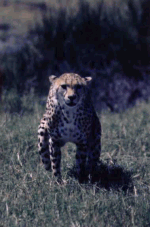 As the plane landed on the dirt strip lined with red oat grass, what had appeared from the air to be tiny specks transformed into full-size, grazing zebras, giraffes, and wildebeest. The intrusion by the sound of the prop did not disturb the grazing herds.
As the plane landed on the dirt strip lined with red oat grass, what had appeared from the air to be tiny specks transformed into full-size, grazing zebras, giraffes, and wildebeest. The intrusion by the sound of the prop did not disturb the grazing herds.
Two six-passenger open-hatch, four-wheel land rovers met us at the strip. Swarthy, Swahili-speaking guides, Allan Earnshaw and Tim Melesi, offering a combined 30 years of experience as African safari guides, welcomed us to the plains of the Serengeti in Tanzania.
Our “airport transfer” to our campsite at Moru kopje was not the typical traveler’s shuttle ride to a local motel. Along the dirt track, we frequently stopped to observed some of the 1.3 million wildebeest (white-bearded gnus) and Burchell’s zebras migrating north from Tanzania to the greener pastures of Kenya. We marveled at Thompson gazelles, topi and warthogs, running comically with upright tails. Lilac-breasted rollers, superb starlings, and blacksmith and crowned glovers wowed the birdwatchers in our group of eight. We listened to the shrieking cry of the turaco, referred to as a “bare-faced” bird with a” go-away” call. A marabou stork perched on a tree patiently waiting his turn as jackals and hyenas devoured a zebra.
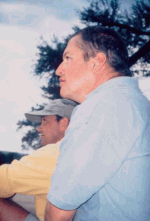 The Moru campsite was located at the base of a colorful, unique rock outcropping or kopjes typical of the flat-topped, thorny acacia and grass savannah of the Serengeti. Our excited group tumbled out of the vehicles to explore the campsite we would call home for the next several days.
The Moru campsite was located at the base of a colorful, unique rock outcropping or kopjes typical of the flat-topped, thorny acacia and grass savannah of the Serengeti. Our excited group tumbled out of the vehicles to explore the campsite we would call home for the next several days.
Each tent included an awning-covered “front porch” with a chair, a two-cot “bedroom” with dressing room, and a separate toilet-shower area. The “toilet” was a porta-potty with a pail of dirt and a trowel, a substitute for flushing water. The shower consisted of water, heated by the campfire, and then hoisted in a bag above the tent. We had three minutes of gravity-fed water to cleanse ourselves from the dust of the plains.
As we watched the sunset around the campfire, Tim’s effervescent enthusiasm and love for Africa, combined with Allan’s canny tracking, smelling, and listening skills, made these two Kenyan-born men, perfect guiding partners. Tim was sharing one of his previous adventures, “I went into the bush to take a leak and I stepped on this bloody, deadly puff adder snake.” When I yelled for Allan’s help. He said, “Shut up, I’m listening on my short-wave radio to the Dow Jones report on BBC news.” Apparently, this kind of experience is simply another day in the bush for this pair of experienced guides. We soaked in their amusing rapport before wandering to our tents for the night.
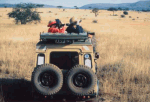 The firm-mattress cot was covered with wool blankets and a colorful African bedspread. I pulled the covers over my head to warm from the chilly 50-degrees of the night. I could hear lions roaring, wildebeest grunting, zebra “chirping,” and baboons babbling. Just as I began dozing, I was jolted awake by an unforgettable, raspy “sawing” call, vibrating much too close to my tent. The next morning, I learned that this unusual cry was that of an amorous leopard searching nearby for his mate. The thin canvas of the tent was the only barrier separating me from the nocturnal animals roaming the surrounding bush.
The firm-mattress cot was covered with wool blankets and a colorful African bedspread. I pulled the covers over my head to warm from the chilly 50-degrees of the night. I could hear lions roaring, wildebeest grunting, zebra “chirping,” and baboons babbling. Just as I began dozing, I was jolted awake by an unforgettable, raspy “sawing” call, vibrating much too close to my tent. The next morning, I learned that this unusual cry was that of an amorous leopard searching nearby for his mate. The thin canvas of the tent was the only barrier separating me from the nocturnal animals roaming the surrounding bush.
Game drives began shortly after sunrise after a warm mug of coffee or tea was delivered to our tents, a wake-up call. We ate a quick breakfast in the dining tent before heading down dirt roads searching for animals. Meals were scheduled around game drives-although a sandwich might easily be tossed aside for the chance to see an elusive African wild hunting dog or greater kudu. Typically, we returned for lunch and a rest period, then set out on a second game drive late in the afternoon.
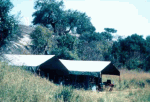 Although the migration of the wildebeest was a spectacular sight in itself, it also afforded us the opportunity to see more than 100 lions in the Serengeti. One afternoon on the savannah, we discovered a majestic golden-manned male dragging his rear paw behind him. Allan and Tim surmised that the lion had been bitten by a venomous spitting cobra. We saw prides of lions lounging on kopjes and cubs nursing and tumbling among the adults. We watched lions pair for mating, stalking prey, and eating their kill. We even observed one lion sleeping in a tree, his stomach bulging from a recent gorge.
Although the migration of the wildebeest was a spectacular sight in itself, it also afforded us the opportunity to see more than 100 lions in the Serengeti. One afternoon on the savannah, we discovered a majestic golden-manned male dragging his rear paw behind him. Allan and Tim surmised that the lion had been bitten by a venomous spitting cobra. We saw prides of lions lounging on kopjes and cubs nursing and tumbling among the adults. We watched lions pair for mating, stalking prey, and eating their kill. We even observed one lion sleeping in a tree, his stomach bulging from a recent gorge.
And these weren’t the only big cats we saw. Having heard the leopards’ love songs during the night, Allan successfully skillfully located the male leopard slinking through tall grass. Climbing the steep pitch of a nearby kopje, the leopard emerged on the opposite side of the outcropping. Seeking cover, he quickly crossed the track in front of us and disappeared into the thick bush of an adjacent kopje.
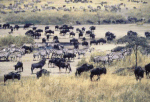 Our luck in finding the leopard was only the beginning- during the next 24 hours, we saw the rest of the “big five” on everyone’s wish list of African animals. Another early morning game drive took us across rugged terrain covered with herds of Thompson’s gazelles, the favorite prey of cheetah. Later in the day, we happily found four cheetahs openly sunning themselves next to a pond. A black rhinoceros stood in the distance, a lone cape buffalo glared at us from nearby bushes. Returning to camp, we saw a herd of elephants grazing near a stream.
Our luck in finding the leopard was only the beginning- during the next 24 hours, we saw the rest of the “big five” on everyone’s wish list of African animals. Another early morning game drive took us across rugged terrain covered with herds of Thompson’s gazelles, the favorite prey of cheetah. Later in the day, we happily found four cheetahs openly sunning themselves next to a pond. A black rhinoceros stood in the distance, a lone cape buffalo glared at us from nearby bushes. Returning to camp, we saw a herd of elephants grazing near a stream.
Oxpecker birds dined on ticks while perched on the backs of many animals, including the giraffes. Bat-eared foxes and honey badgers peeked at us as they scrambled into their burrows for cover. In the tall grass, a pink-legged male ostrich flapped his wings in a mating ritual. We saw the brown-black topi antelope, a male vervet monkey with its midnight-blue scrotum, and smaller antelopes such as the klipspringer and Kirk’s dikdik.
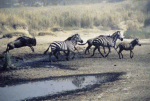 The red oat grass was mixed with thorny acacia and cloth grabbing “wait-a minute” bush. Magnificent euphorbia candelabra surrounded the crusty white “soda” banks near Lake Magadi. We knew that clouds of dust in the distance meant sightings of animal migrations.
The red oat grass was mixed with thorny acacia and cloth grabbing “wait-a minute” bush. Magnificent euphorbia candelabra surrounded the crusty white “soda” banks near Lake Magadi. We knew that clouds of dust in the distance meant sightings of animal migrations.
Petroglyphs carved into the boulders showed evidence of ancient civilizations, an unexplained archeological message. Shiny, black obsidian fragments and remnants of a stone circumcision tool lying near the bed of a water hole added to the mystery of this land’s ancient inhabitants.
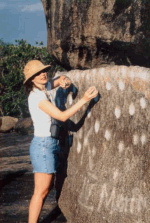 After a day of game driving, we enjoyed spectacular sunsets as we sat around a campfire sipping “sundowners.” The sky glowed with ribbons of red and gold while our group of adventurers gathered to relax, converse, and revel in a sense of camaraderie that only comes from sharing an enthralling safari.
After a day of game driving, we enjoyed spectacular sunsets as we sat around a campfire sipping “sundowners.” The sky glowed with ribbons of red and gold while our group of adventurers gathered to relax, converse, and revel in a sense of camaraderie that only comes from sharing an enthralling safari.
Dinner was more elaborate than a camper’s standard freeze-dried meals. Every night, our nine-person crew produced gourmet dinners that might include an entrée of steak or pork chops cooked over wood-burning grates, or a pasta dish baked in Dutch ovens. Elegant meals, which also included soup, salad, vegetables, and dessert, were served on fine dinnerware atop a beautifully clothed, candlelit table. The hard-working crew cleaned our tents, washed our clothes, turned down our beds, and even zipped our tents securely each night.
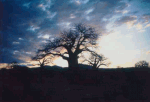 We headed for our tents shortly after dinner. We would spend another night listening to the nocturnal calls of animals through the thin canvas tent, looking forward to our next game drive.
We headed for our tents shortly after dinner. We would spend another night listening to the nocturnal calls of animals through the thin canvas tent, looking forward to our next game drive.
